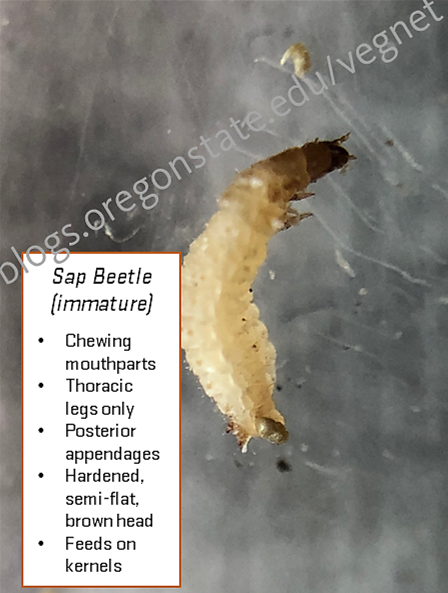You’ll notice that we emphasize the importance of ‘scouting’ on this blog a lot, but what is one supposed to do when they find something? Lots of immature bugs can be found in the soil and it can be difficult to distinguish a “baby” beetle from a fly from a caterpillar, etc. This post might help…
Please know – I plan on developing a more detailed resource, but for now – it’s spring, people have questions – I won’t have time to reinvent the “immature ID” wheel until fall – – especially when a great resource already exists (Univ. of Kentucky, see below). Apologies for the quality of the photo, but truly, this is such a need that posting anything is better than nothing!
*** Use these steps to follow along a chosen path and end up with at least some idea of what your specimen is.
I developed this key as a companion to the figure below ***
- START: Does your insect have 3 pairs of legs on the thorax (segment just behind the head)?
- YES – go to step 2;
- NO – go to step 8
- Does your insect have fleshy legs (prolegs) on the rest of its body?
- YES – go to step 3;
- NO – go to step 5
- Are there more than 5 pairs of prolegs on the abdomen?
- YES……….. your specimen is probably a sawfly.
- NO – go to step 4
- Are there 5 or fewer pairs of prolegs on the abdomen?
- YES, there are 5……..your specimen could be a cutworm, armyworm, corn earworm, webworm, cabbage white butterfly, or other type of Lepidoptera
- YES, there appear to be 4 or 3…… your specimen is probably a cabbage or alfalfa looper. Vestigial legs are reduced, this contributes to the apparent ‘looping motion‘ of the larvae
- YES, there are 2…….your specimen was likely found on a tree or shrub and is a ‘true’ looper (Lepidoptera: Geometridae)
- Look again at the true legs, located on the thorax. Are they long?
- YES – go to step 6;
- NO – go to step 7
- Your specimen may be an immature lacewing, ladybug, or ground beetle. Surprise! These all look very different from their adult forms but they are beneficial predators! Learn more about beneficial insects.
- Your specimen is likely an immature beetle that can cause damage. They go by many names: grubs, wireworms, rootworms, flea beetle, carpet beetle to name a few.
- Ok, so there are no apparent legs on the thorax (Follow the solid orange arrow). Does the insect have a distinct and visible head?
- YES – go to step 9;
- NO – go to step 11
- If the specimen was found in an aquatic environment, it is probably an immature midge, mosquito, or drain fly. If not, go to step 10.
- Fungus gnats can be an issue in greenhouse and nursery production. Weevil grubs live in the soil and are plump and legless; here is some good information about root weevils.
- Does your insect have no legs and no visible head? The most likely answer is that you have a cranefly or a maggot. Both are found in the soil and can be quite destructive. Syrphid fly larvae look similar to maggots and can be beneficial or secondary pests that contribute to decay, depending on the situation.

Dusky sap beetle 
Corn earworm 
Rootworm 
Pea weevil 
Wireworm 
Seed corn maggot 
Cranefly 
Cabbage looper
